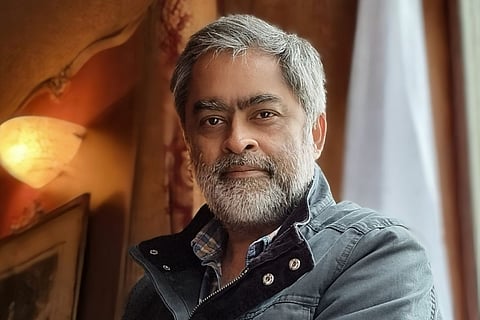
- LIFESTYLE
- FASHION
- FOOD
- ENTERTAINMENT
- EVENTS
- CULTURE
- VIDEOS
- WEB STORIES
- GALLERIES
- GADGETS
- CAR & BIKE
- SOCIETY
- TRAVEL
- NORTH EAST
- INDULGE CONNECT

It had been a dream of ace cinematographer Arvind Krishna to be part of a biopic, so when he was asked to crank the camera for the recently released Swatantrya Veer Savarkar, he instantly agreed to be on board.
“It all actually happened at the last minute. Randeep Hooda (the lead actor, producer, and director of the film) called me up two-three days before the film went on floors. I was always keen on doing a biopic to see how it looked, and I said 'yes' to the project.”
Arvind Krishna says that projects that delve into history come with their own set of challenges. “The first challenge, of course, is to give it a period look and feel, but at the same time, people should be able to relate to it as well. We did a lot of filming in black and white, and added a pop of colour. We shot in different conditions and in different places. We went to Andaman and shot in the Cellular Jail, which was nerve-wracking. Making biopics can be arduous, and I think Randeep has done a phenomenal job at it.”
Arvind Krishna, who began his cinematography stint with director Selvaraghavan's Thulluvadho Ilaimai (2002), has come a long way. Ask him how cinematography has evolved over the years, and he says, “We are in the digital era. For people like us to adjust and adapt to it from the film stock world, it was a huge challenge, but a compelling one at that. Today, things are changing at a rapid pace, so you have to stay abreast of the developments. The cameras and technology are all evolving, and it's beautiful to be part of this transition.”
Elaborating on the role of cinematography in bringing out the visual aesthetics of the film, Arvind says, “It is a demanding job. Cinematographers are basically trying to convert the vision of the director. We try to enhance what they see or perceive as a story and how best we can capture their perspective and bring it on screen. That's the reason they say that the director and cinematographer need to be 'married' to each other. Once you're in sync with the filmmaker, you know what's going on in their mind and how they expect things to be. It's a huge process. We discuss things like how he expects the lighting or the mood to be, and accordingly, we determine the location.”
Arvind says that, in terms of cinematography, Swatantrya Veer Savarkar, has been a tough nut to crack. “In fact, the previous outing, the web series Cat, was engrossing because we tried something different with a lot of negative spacing. It was a period film as well, spanning from 1990 to 2006. So, we had to distinctly show the differences between the time periods.”
Arvind had created quite an impression with his acting prowess in Kuruthipunal and Kandukundain Kandukondain. When asked why he didn't pursue his acting career further, he replies, "Acting happened by chance. But yes, I always wanted to act. But then I think destiny chose me to become a cinematographer, and I have absolutely no qualms or regrets about it. Having said that, if I get a chance to face the camera, I would love to give it a shot. At the same time, I am aware of my limitations as an actor, what I can do, and what I can't. Any role that suits me, I am glad to take it up.”
However, Arvind adds that his prime focus is on cinematography. “That's more challenging and interesting right now because of technology and everything. How we use these to be innovative and creative is a big challenge. Use of the correct technology and the right space and content is going to be the key moving forward.”
So, who are the cinematographers he looks up to among the current crop of cinematographers? “Well, I have a long list. Robert Richardson, Roger Deakins, and, of course, my boss, PC Sreeram and Ashok Mehta, to name a few. You learn from them how to go about approaching a film. It's not just the lighting and the composition, but how they approach the film as a cinematographer. The tonality of the project will keep changing, but how you tell the story through your lens is what makes the difference. Take the case of Agni Natchathiram, or Alaipayudhey. The films were visually diverse, and the use of colours was spellbinding.”
Arvind says that among the recent releases, the Malayalam survival thriller Manjummel Boys, helmed by Chidambaram, was quite impressive. “The way they created the film was quite interesting. It's a simple thread, and it's really difficult to engage people for two hours. But the way they approached the film, with that kind of storyline and emotion, with the flashbacks, back and forth, it's all interesting. And for each instance, they gave a kind of flashback as a precursor to how the developments were going to be. It was a well-written script and had well-executed shots.”
How do you see the future of cinematography? “It is going to get a little tougher because technology is changing drastically. Content is going to be the king. We as cinematographers need to find new ways to get the content out using the ever-changing tools.”
When asked what he would have been, if not a cinematographer, he says, “Well, actor was one choice, but now, I am a cinematographer. I think eventually, at some point, maybe after three - five years, I might take the plunge into direction,” says the director, who is working on a film with director Vijay and a Hindi project.
You can contact the writer over email at sangeetha.p@newindianexpress.com and follow her on Twitter @psangeetha2112